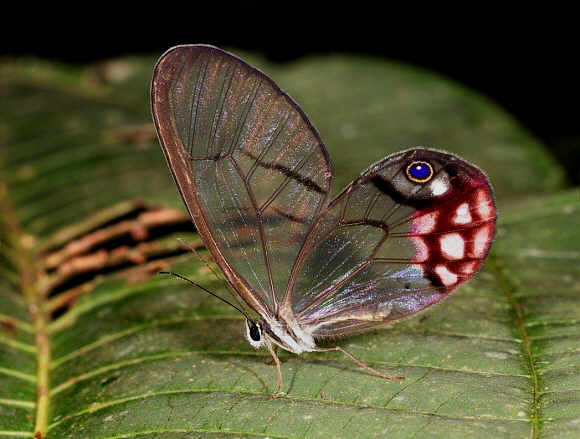
Introduction
The colours of butterflies are produced by pigments in the wings scales, and sometimes structurally, by light refracting on prism-like ridges on the surface of the scales. Some species however are very thinly scaled, or lack wing scales almost entirely, revealing the transparent membrane of the wings.
The tribe Haeterini is confined exclusively to the neotropical region. All members of this tribe are elusive crepuscular butterflies which spend their lives skulking deep in the undergrowth. There are 5 genera – Pierella, Pseudohaetera, Haetera, Dulcedo and Cithaerias. All butterflies in the latter 4 genera have rounded transparent wings, with small ocelli at the apex of the hindwings.
There is contention amongst taxonomists as to the true number of species in the genus Cithaerias. Some consider there to be as many as 15 species, but to quote Bernard d’Abrera “it all depends on how you define a species”. The Lamas neotropical checklist ( 2005 ) only lists 5 – pireta ( previously known as menander ), andromeda, phantoma, pyritosa and pyropina.
Because of the confusion about how many Cithaerias species actually exist, it is almost impossible to give a reliable guide to the distribution range of this or any of the other very similar members of the genus.
Habitats
This species, in common with all members of the Haeterini, is found only in deeply shaded areas of rainforest. It appears to occur at altitudes between sea level and about 1500m, in Ecuador, Peru, Bolivia and south-west Brazil, but there is much confusion regarding the geographical ranges of the various species and subspecies in this genus.
Lifecycle
Nothing is known of the lifecycle or foodplants of Cithaerias species. However it is possible to make some educated guesses. The larvae of almost all Satyrine butterflies feed on monocotyledons, i.e. grasses, palms, bamboos, sedges, rushes, orchids & lilies.
Cithaerias butterflies tend to be associated more strongly with palm than with bamboos or other monocotyledons. The larvae are likely to be similar to those of other Satyrines, namely slim, cylindrical, dull greenish or brownish in colour, with thin longitudinal stripes along the back and sides, devoid of setae or tubercles, and possessing caudal prongs, and a pair of knob-like projections on the head.
Adult behaviour
The adults are almost always encountered singly. They are denizens of the darkest and dampest recesses of the rainforest, and appear to be very localised. The butterflies are crepuscular in nature – they can sometimes be found in the middle of the day, but are far more often encountered at dusk than at any other time.
The flight is low over the ground, skulking and phantom-like. The wing beats are deep and slow, but the butterfly is capable of moving rapidly if disturbed. Upon settling it usually turns quickly around, and tilts slightly forward so that the “false eye” on the underside hindwing is raised. This ocellus, together with the bright pink area, and the oval shape of the hindwings, may function to simulate the head of a small snake, deterring any bird, reptile or amphibian that detects where it has settled.
The butterflies tend to remain deep in the undergrowth, but emerge at dusk to feed at rotting palm fruits on the forest floor, or on fluids exuding from decomposing fungi. They remain stationary for long periods, but are easily put up, and if disturbed retreat into the undergrowth. However they are habitual in behaviour, and often return within a few minutes.
